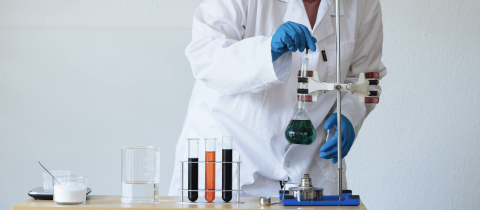To the surprise of many, however, cancer cells are defective at producing the very fuel they need to grow and spread, but manage to overcome the innate “disability” and out-compete normal healthy cells? How?
A quick recap: For cells to sustain their activities, they need fuel. This is supplied in the form of molecules called adenosine triphosphate or ATP. The source of ATP in turn is glucose, a simple “sugar.” Sugars are a class of sweet-tasting carbohydrates that include fructose (fruit sugar), lactose (milk sugar), and sucrose or table sugar, a “disaccharide” composed of glucose linked to fructose.
All these sugars are eventually converted to glucose in the body, mostly in the small intestine, with the help of digestive enzymes. Hence, the orange juice you had for breakfast, the rock sugar you added to the coffee, and the warm milk you savour before bedtime all yield glucose.
For normal healthy cells, each glucose molecule yields 32 molecules of ATP. This fuel production line consists of three sequential stages: First, glucose is broken down into pyruvate, a simpler compound (Stage 1) which then initiates a series of reactions known as the citric acid or “Krebs” cycle (Stage 2), followed by another sequence of reactions known as oxidative phosphorylation (Stage 3). These stages yield 2, 2, and 28 molecules of ATP, respectively. Clearly, Stage 3 is the most productive!
The defect of cancer cells is that they are only capable of Stage 1 ATP production. This means that from a single glucose molecule, cancer cells can only extract 2 molecules of ATP, unlike normal cells capable of generating 32 such molecules.
To make up for the deficiency in ATP, cancer cells must maximize Stage 1 reactions. Since Stage I requires glucose, as far as cancer cells are concerned, the greater the glucose supply, the happier and more productive they become.
Can cutting sugar starve cancer?
Given that cancer cells are addicted to sugar, can they be starved, and possibly killed, by depriving them of sugar? The short answer: NO.
First and foremost, glucose is needed for all our body cells to function. A lack of glucose would affect normal cellular and bodily functions as well. Our body also has a “saving it for the rainy day” contingency plan to generate glucose should the supply in the diet run low. For a starter, the liver maintains a store of glycogen, a giant molecule, a “polymer,” made up of a chain of glucose units. When levels of glucose in the blood fall, the pancreas releases the hormone glucagon that signals the liver to convert glycogen into glucose. Cancer cells can also benefit from this fresh supply of glucose. So you see, it would be impossible and unrealistic to deprive cancer cells of their coveted glucose from diet.
Another cancer trick
Recall Stage 3 ATP production discussed earlier in this article that cancer cells are defective in producing ATP using glucose for that stage? A research group at NYU Langone, one of the nation's premier academic medical centers, has reported meticulous observations of pancreatic cancer cells using alanine as a glucose substitute. Alanine is one of the 20 amino acids our body uses to build proteins. Additional observations made by the same group reveal special “warehouses” built by pancreatic cancer cells for nutrient and fuel supply. This offers opportunities for pharmacological intervention to cut off the supply of nutrients vital for cancer cell survival.
Even though there is no direct causal link evidence between excess sugar and cancer, observational studies as described by the US National Cancer Institute, point to an association between excess body fat and increased risk of cancer including esophageal and gastric cancer, breast cancer, liver cancer, and colon cancer. Hence, it is generally good practice to watch sugar intake in one’s diet to avoid excess sugar that ends up being converted to body fat.
Can we wake up dormant immune cells?
You might also wonder why immune cells like Killer T cells and Natural Killer cells that normally target foreign invaders manage to travel to a tumour site yet end up sitting on the sidelines and letting cancer cells wreak havoc? Thought-provoking!
Immunologists asked the same question, probed far and deep, and came up with exciting findings. Two groups pioneered by Dr. James Alison (MD Anderson Cancer Center, Houston TX USA) and Dr. Tasuku Honjo (Kyoto University, Kyoto Japan) were awarded the 2018 Nobel Prize for their respective discovery of cancer therapy that re-energizes immune cells to mount attacks against cancer cells. The idea is to block the action of proteins that have been christened PD-L1 and CTLA-4 which are found on the surface of immune cells and act as a “brake” to keep the immune cells from killing other cells.
“Immune therapy” involves the use of drugs that unlock the brakes by interfering with the activity of PD-L1 and CTLA-4, the proteins that keep the body’s immune response in check. There are a number of such drugs available to treat more than a dozen different types of cancer, including breast cancer, lung cancer, liver cancer, and melanoma. More encouraging news: A combination of drugs has shown enhanced efficacy of more than 50% in patient response, compared to “monotherapy.”
Invariably, in science, the answer to one question often leads to more questions. Will cancer cells play additional “molecular” tricks to skirt around the PD-1 or CTLA-4 blocking drugs? Will “personalized” immune therapy that takes into account cancer’s mutational landscape variations from patient to patient become optimized?
No question that we are off to a good start on the road to more efficacious cancer therapy. The advent of big data and machine learning (another topic, another time) is likely to speed our journey.
Dr. Nancy Liu-Sullivan holds a Ph.D. in biology and served as a senior research scientist at Memorial Sloan Kettering Cancer Center. She currently teaches biology at the College of Staten Island, City University of New York.







